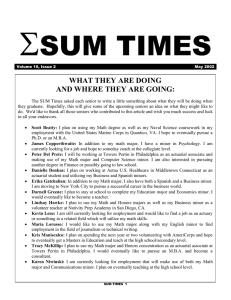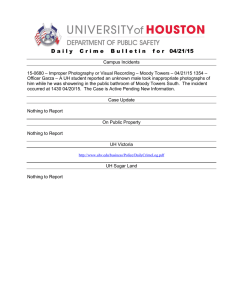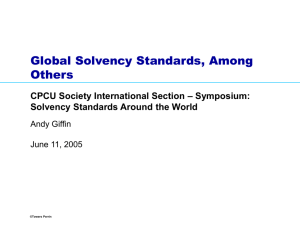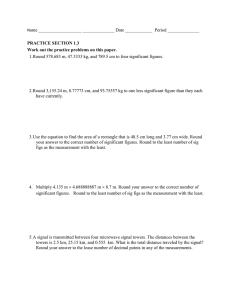CAMAR - Spring 2005 Meeting Princeton, NJ June 2, 2005
advertisement
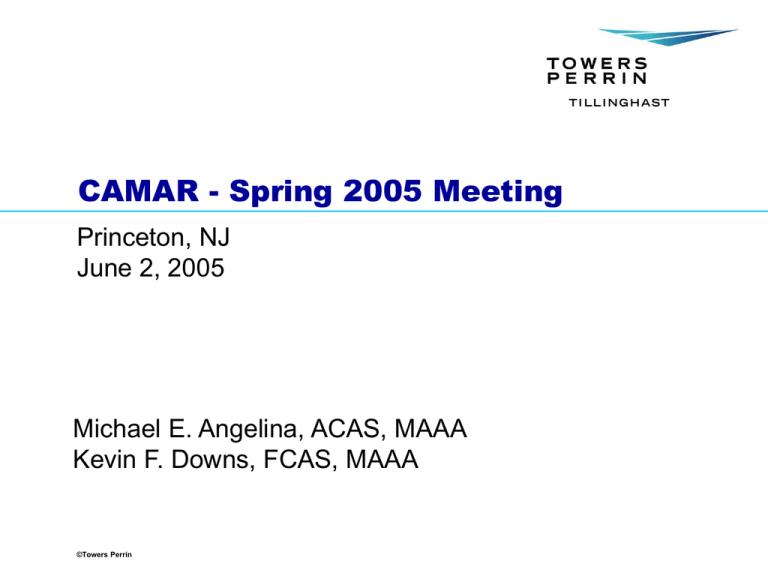
CAMAR - Spring 2005 Meeting Princeton, NJ June 2, 2005 Michael E. Angelina, ACAS, MAAA Kevin F. Downs, FCAS, MAAA ©Towers Perrin Agenda Concerns in the Current System Quantification of Liabilities Potential Solutions ©Towers Perrin 2 Concerns in the Current System (1) Plaintiffs should demonstrate injury to file a claim The number of claim filings has increased dramatically 2003 claim filings against the Manville Trust exceeded 100,000 Fewer than 10% of claims are malignant Per RAND, ⅔ to ¾ are unimpaired The right to seek recovery if/when an injury manifests should not be limited Each claim should stand on its own merit Restrictions on mass consolidations Venue should be controlled Avoid forum shopping in “magic jurisdictions” ©Towers Perrin 3 Surge in Claim Filings Manville Trust - Injury by Year Filed 100,000 90,000 (Denied) or Unknow n 80,000 Non-Malignant Cancer Mesothelioma Number of Claims 70,000 60,000 50,000 40,000 30,000 20,000 10,000 0 1990 1991 1992 1993 1994 1995 1996 1997 1998 1999 2000 2001 2002 2003 Year Filed 2004 Manville Trust Claim Filings: 14,500 2005 Manville Trust Claim Filings: 9,300 at May 2005; 22,320 annualized Note: Excludes Non-U.S. claims ©Towers Perrin 4 Change in Disease Mix Manville Trust - Injury by Year Filed 100% 90% Percent of Claims Filed by Category 80% Non-Malignant 70% Cancer 60% 81% 82% 84% 89% 85% 86% 85% 92% 89% 88% 91% 93% 90% 90% 6% 7% Mesothelioma 50% 40% 30% 20% 13% 12% 6% 6% 5% 4% 5% 1990 1991 1992 1993 1994 10% 11% 7% 0% 9% 10% 9% 7% 8% 4% 6% 2% 5% 4% 4% 6% 3% 4% 2% 4% 3% 1995 1996 1997 1998 1999 2000 2001 2002 2003 Year Filed ©Towers Perrin 5 Evidence of Forum Shopping 100 MD Other states 80 TX 60 Percent IL 40 NJ OH MS PA WV 20 NY CA 0 1970–1987 ©Towers Perrin 1988–1993 Source: RAND, January 2003 1994–1997 1998–2000 6 Increasing Numbers of Claimants Are Unimpaired 1982 4% of claims showed no manifest asbestos-related injury (RAND) 1993 Up to one-half of all asbestos claims have little or no physical impairment (Harvard Journal of Legislation) 1998 No evidence of disease in 57% of asbestos claims (Manville Trust) 74% of pending claims are unimpaired (confidential report prepared for a defendant) 2001 Two-thirds of claims show no evidence of impairment (Babcock & Wilcox) Vast majority of claims provide no evidence of impairment (W.R. Grace) ©Towers Perrin Source: RAND 7 Concerns in the Current System (2) A low percentage of total payments have reached the claimants. Per RAND: 30% - defense transaction costs 29% - plaintiff attorney fees and legal costs 41% - to claimants Resources are limited 77 defendant companies have sought bankruptcy protection But defendant pool has increased to ~8,400 Future sick may not be compensated ©Towers Perrin 8 Number of Asbestos Related Bankruptcies per Year 14 12 12 10 Number 10 8 7 6 5 4 4 4 3 3 3 2 2 2 1 5 2 2 2 2 1 1 0 1 1 0 0 1983 1985 1987 1989 1991 1993 1995 1997 1999 2001 2003 2005 While only five bankruptcy petitions were filed during each of 2003 and 2004, the reduced level should not be misinterpreted as a sign of improvement in the asbestos litigation crisis. Rather, the number of 2003-2004 petitions was likely lower as defendants delayed decisions as they awaited the outcome of federal reform efforts. ©Towers Perrin Note: Graph excludes a bankruptcy in 1976. 9 Differences Between Traditional and PrePackaged Bankruptcies Traditional Pre-Packaged Can take years to complete1 File petition Negotiate with creditors File reorganization plan File disclosure statement Solicit votes Confirmation hearing Intended to be completed within a few months of filing Negotiated and voted on before filing Combined hearing to confirm plan and disclosure Insurance coverage generally exhausted or settled, or insurers included in negotiations Insurers interests are not represented in prepetition negotiations Court appoints claimant representatives Future’s Rep involved in negotiation for >50% equity Commonly include a pre-petition trust to pay near full value on current claims Plaintiff attorneys with large inventories negotiate matrix agreements that benefit their own clients, but do not owe a duty to all claimants Disease criteria broadly defined Claimants not fully compensated, so remain eligible to vote on the bankruptcy plan Generous awards to lower disease severity classes Significant portion of equity can be secured (therefore not available to bankruptcy trust) 1 Johns Manville filed bankruptcy in 1982 and its plan was not confirmed until 1988; Babcock & Wilcox filed bankruptcy in 2000 and its plan has not yet been confirmed. ©Towers Perrin 10 Problems with Pre-Packaged Bankruptcies Negotiated in secret by a select group of lawyers, whose clients receive preferential treatment relative to other claimants with similar disease Future’s Representative bound by pre-petition settlements Debtor is negotiating with insurers’ money Conflicts of interest are abundant Source: Mark D. Plevin/Crowell & Moring LLP ©Towers Perrin 11 Independence vs. Conflicts of Interest? AC&S’ counsel for pre-packaged AC&S bankruptcy GHR Also negotiating AC&S claim settlements Joseph Rice/Ness Motley Pre-petition Committee 70% Ownership “Independent” claim reviewer Pre-petition Trust – Categories A, Bx, By, C, D Paid $3M to review documentation Kenesis of 250,000 Category D claimants Purchased Clearing House in June 2003 Paid $2M as subcontractor of Clearing House Kenesis Sole proprietor, J. Benee Wallace, paralegal of Ness Motley From appointment of Kenesis (5/2002) until pre-package bankruptcy filed (9/16/2003), AC&S settled more than $2 billion of claims Settlements over prior 20 years totaled $600 million Pre-packaged plan stipulated that these settlements could not be challenged by the asbestos trust or AC&S ©Towers Perrin 12 AC&S Plan Denied Confirmation On 1/23/04 Judge Newsome (Delaware federal bankruptcy court) denied confirmation of the AC&S pre-packaged bankruptcy plan, finding that the plan Was not proposed in good faith Unjustly prejudiced by plaintiff attorneys Largely drafted by and for the benefit of the pre-petition committee through various pre-petition settlements Unfairly favors one plaintiff over another Fundamentally unfair that one claimant with nonsymptomatic pleural plaques will be paid in full, while someone with mesothelioma runs the substantial risk of receiving nothing Both should be compensated based on the nature of their injuries, not based on the influence and cunning of their lawyers “The court is informed that other judges have confirmed plans with such discriminatory classifications. This judge cannot do so in good conscience.” ©Towers Perrin 13 How to Quantify Asbestos Liabilities? Many use benchmarks or rules of thumb Market share techniques For example, 5% of GL premium volume for affected years translates to 5% share of ultimate liabilities Survival ratio techniques equals ratio of total reserves divided by average annual payments U.S. net asbestos survival ratio at year-ends 2001, 2002, 2003 = 8.8, 11.4, 10.6, respectively A.M. Best using an undiscounted survival ratio of 18 - 20. Aggregate development multiples of paid losses, case reserves, or reported losses Comparisons to peer companies (e.g., significant reserve additions) ©Towers Perrin 14 How to Quantify Asbestos Liabilities? Exposure-based modeling will improve understanding of ultimate A&E liabilities For an insurer or reinsurer, it considers Mix of insureds Types of coverage Policy wording Attachment points and limits Years of coverage Claims handling and settlement activities Greater understanding equips the defendant, insurer, or reinsurer to deal strategically with its exposure ©Towers Perrin 15 Asbestos Insurer/Reinsurer Exposure-Based Analysis Steps: (1) Identification of exposure to asbestos defendants (2) Projection of ground-up ultimate loss and expense for known asbestos defendants (3) Allocation of defendant losses across coverage block (4) Comparison of losses in a given year to insurer / reinsurer coverage terms (5) Provision for non-products losses (6) Provision property damage, DJ expense (7) Provision for “pure” IBNR (8) Ceded / net analysis (9) Provision for uncertainty ©Towers Perrin 16 Asbestos Insurer/Reinsurer Exposure-Based Analysis The Types of Asbestos Defendants Tier 1: Manufacturer/producers in litigation since inception Will use all available insurance coverage Tier 2: Became involved shortly after Tier 1 companies Some will exhaust all insurance coverage Others will not hit highest layers due to smaller share of industry ©Towers Perrin Tier 3: Manufacturers, distributors and installers brought into litigation due to Tier 1 and Tier 2 bankruptcies Lesser exposure due to encapsulated products or limited distribution Tier 4: Owned/operated facilities where asbestos used and third parties exposed on premises 17 Exposure-Based Analysis: (1) Identification of Exposure to Asbestos Defendants List all asbestos claims / notices Identify all coverage issued to major asbestos defendants Review non-asbestos claims/notices Search of underwriting records for direct coverage and facultative reinsurance Cedent audits for reinsurers’ treaty business Review coverage profiles of major defendants to identify cedent involvement and potential reinsurer treaty coverage Research corporate genealogy Identify producers of “at risk” products ©Towers Perrin 18 Exposure-Based Analysis: (1) Identification of Exposure to Asbestos Defendants Practical Issues: “Missing” coverage Unknown coverage terms Exclusions in underlying policies Reinsurer attachment relative to first dollar Potential reinsurer benefit from client’s inuring facultative coverage ©Towers Perrin 19 Exposure-Based Analysis: (2) Projection of Ultimate Ground-Up Loss and Expense for an Asbestos Defendant Frequency / severity projection Project future claim filings Select average indemnity and future trend Estimate expense load Special considerations Coverage exhaustion / settlements Bankruptcies Changing litigation profile of the defendant Incremental v. cumulative experience Changes in mix of claims by disease and state ©Towers Perrin 20 Exposure-Based Analysis: (2) Projection of Ultimate Ground-Up Loss and Expense for an Asbestos Defendant Transaction costs have consumed more than half of total spending and are likely to increase in the future No formal joint defense mechanisms remain (e.g., ACF, CCR) “Settlement” philosophy hasn’t worked Newer defendants Discovery costs (product, coverage) “Fight or die” ©Towers Perrin 21 Exposure-Based Analysis: (3) Allocation of Defendant Losses Across Coverage Block Allocate ground-up ultimate indemnity and expense to year Compare to available coverage Reflect expense treatment (varies by policy) Consider coverage disputes, choice of law Consider other erosion of products aggregate limits Consider reinsurance cessions to estimate net losses Asbestos Insured XYZ's Coverage Chart Coverage Amount $ Excess 5 Excess 4 Excess 3 Excess 2 Excess 1 ----------------- Self - Insured -------------------- Primary 1930 … 1978 1979 1980 1981 1982 1983 1984 1985 1986 Year ©Towers Perrin 22 Exposure-Based Analysis: (4) Comparison of Losses to Coverage Terms Example: More detailed coverage description of Excess 1 Layer in 1980 8 Excess 2 $ Millions 6 4 Excess 1 10% Insurer ABC Excess 1 20% Insurer DEF Excess 1 Excess 1 10% Excess 1 70% Insurer 70% Insurer ABC Insurer GHI GHI 2 0 1980 Primary - Insurer JKL ©Towers Perrin 23 Exposure-Based Analysis: (4) Comparison of Losses to Coverage Terms Example: Comparison of Losses in a Given Year to Insurer / Reinsurer Coverage Terms If Insurer ABC wrote 10% of $5 million xs of $1 million in 1980, and ultimate losses allocated to 1980 totaled $1,000,000, then Insurer ABC’s gross liability would be $0 $4,000,000, then Insurer ABC’s gross liability would be $300,000 (= 10% x ($4,000,000 – $1,000,000)) $6 million, then Insurer ABC’s gross liability would exhaust its limit of $500,000 ©Towers Perrin 24 Exposure-Based Analysis: (5) Provision for Non-Products Losses Non-products losses without products exposure Most often premises related For most, absence of aggregate limits has no impact Non-products losses by traditional products defendants A limited number of traditional products defendants have been successful in bringing non-products claims Attorneys are clever Generally due to exhausted products coverage “Reclassify” claims to reinstate products limits File operations claims to access additional coverage, generally written without aggregate limits Aggregate limits may be imposed Wellington Bankruptcy negotiations Settlements ©Towers Perrin 25 Exposure-Based Analysis: (6) Provision for Property Damage, DJ Expense Significant property damage liability experienced by only a few defendants DJ Expenses Consider ratios of paid DJ/paid loss & ALAE Consider DJ reserves Consider recent DJ payment levels and future multiples Consider (changes in) staffing levels ©Towers Perrin 26 Exposure-Based Analysis: (7) Provision for Pure IBNR Emergence of additional exposure arising from additional coverage / new defendants Estimate annual emergence Estimate future reporting horizon and rate of decline Consider severity of new exposure Adverse development on known accounts Uncertainty with newer risks Coverage identification / ”missing” policies Discovery of liability potential / immature litigation ©Towers Perrin 27 Exposure-Based Analysis: (8) Ceded/Net Analysis Best practice: directly reflect terms of outward reinsurance protections applied to gross loss estimates Model gross, ceded and net directly However, some outward programs are too disparate / complicated to model Some insurers can provide gross estimates to ceded reinsurance department Common practice: review historical net / gross ratios by homogenous groupings Paid ratios may not be reflective of future May be distorted by a few large accounts May not adequately reflect future cessions in excess-of-loss programs Consider reinsurance collectibility: commutations, insolvencies, disputes ©Towers Perrin 28 Exposure-Based Analysis: (9) Provision for Uncertainty Range of estimates considers various scenarios / uncertainty Why have projections missed the mark in the past? Choice of methods Data constraints Specific assumptions External environment ©Towers Perrin Unimpaired claimants Mass screenings Impact on settlements / compensation Dismissals Inactive dockets “Jackpot” awards Bankruptcy Pre-packs Accelerated payments Expansion of “target” defendant list Reform efforts 29 Portion of $200 billion Ultimate Loss and Expense – Retained, Net Insured U.S., Net Non-U.S.** Net NonU.S. Insured Retained by 31% Defendants 39% Net U.S. Insured 30%* *$60 billion mid-point of $55 – $65 billion range of the “Universe” of net liabilities to the U.S. P/C market. **Additional details available in Emphasis 2001/3, “Sizing Up Asbestos Exposure,” a publication of Tillinghast – Towers Perrin, at www.towers.com. ©Towers Perrin 30 $ Billions Paid and Reported Loss and Expense Compared to Estimates of Net U.S. Ultimate Liability 80 80 70 70 60 60 50 50 40 40 30 30 20 20 10 10 0 0 1994 1995 1996 1997 1998 Estimated Ultimate Cost ($55 - $65 billion) 1999 2000 2001 2002 2003 Cumulative Paid ($28.2 billion at 2003) Outstanding Case & IBNR ($22.2 billion at 2003) ©Towers Perrin 31 Recognition of Asbestos Liabilities Gross Incurred Asbestos Loss and Expense Calendar Year 1998 - 2003: Ten Largest Increases Hartford Insurance Group Travelers Prop Cas Group ACE INA Group CNA Insurance Companies* American International Grp Inc* White Mountains Insurance Grp Allianz of America, Inc CY Net Incurred CY Ceded Incurred Liberty Mutual Insurance Cos Allstate Insurance Group* Chubb Group of Insurance Cos* - 500 1,000 1,500 2,000 2,500 3,000 3,500 4,000 4,500 5,000 5,500 Millions Based on Note 29 Annual Statement data as of 12/31/2002 and public disclosures of reserve charges during 2003. *Note, for some companies 2003 gross (or ceded) amounts were not disclosed, so only the net amount is included. ©Towers Perrin 32 Recent Increases in U.S. Asbestos Liabilities U.S. Insurers have increased asbestos reserves by at least $12 billion gross ($8 billion net) since the beginning of 2003 The Hartford – $4.0B gross, $2.6B net (May 2003) Travelers - $3.2B gross, $2.6B net (Jan 2003) ACE USA - $2.2B gross, $0.3B net A&E (Jan 2003) Swiss Re America - $520M gross, $458M net (Q4 2003) CNA - $517M net A&E (Q3 2003) Allstate - $514M net (Q2&Q3 2003) AIG - $440-450M net (Q4 2003) Liberty Mutual - $405M gross, $331M net (Q3 2003) Chubb $250M net (Q4 2003) Argonaut - $52.8m (Mar 2003) Follows further significant increases in 2001 and 2002 Increased pressure on peers to make similar disclosures ©Towers Perrin 33 Recent Increases Abroad Equitas (amounts in Sterling) £1.5B gross undiscounted (Q1 2000) £1.7B gross undiscounted (Q1 2001) No change as of Q1 2002 £0.4B gross discounted (Q1 2003) £0.3B gross discounted (Q1 2004) Royal & Sun Alliance (amounts in Sterling) £371M for U.S. and U.K. (Feb. 2002) £150M for U.S. and U.K. (Sept. 2003) £500M for U.S. and U.K. (March 2004) ©Towers Perrin 34 Themes Underlying Insurer/Reinsurer Charges Some companies recognized increases each year, others less frequently Not all insurers included in the “dirty thirty” have increased reserves by a significant amount Increases in anticipated cessions exceed increases in net amounts recognized by reinsurers Some reinsurance is non-U.S. ©Towers Perrin 35 Comparisons of Reserve Adequacy Need an understanding of the method(s) utilized Prior to 2002 insurer disclosures Guesswork Rules of thumb Disclosures during 2003 Provided first details regarding ground-up exposure- based analyses Specific assumptions underlying the actual analyses are critical and many details are still not disclosed ©Towers Perrin 36 Manville Trust Recent Claim History The Manville 2002 TDP is almost exactly the same as the TDPs in emerging and pending asbestos trusts From October 1, 2003 through March 31, 2005, a period of 18 months, the CRMC received approximately 28,000 Manville Trust claims In the first 9 months of 2003, the CRMC received approximately 90,000 Manville Trust claims Why such a dramatic decrease in claim filings? Source: David Austern, CRMC, April 6, 2005 ACI Meeting ©Towers Perrin 37 2002 Revised Manville Trust Distribution Process (TDP) The 2002 Manville TDP differs from the 1995 TDP in the following ways There is a requirement of Significant Occupational Exposure (“SOE”) There is more stringent medical criteria under the 2002 TDP An independent claims forecaster re-evaluated claims filed between 2000 and 2003 under the 1995 TDP to determine how the claims would have been settled if they had been filed pursuant to the 2002 TDP Expected annual claim payments decreased from (estimated) $146.8 million to $87.9 million Only one-third of the 1995 TDP claims filed in three of the major claim categories met the SOE requirement A significant number of claims failed to meet the more stringent 2002 medical criteria Approximately 50% of the 1995 TDP claims were paid at the lowest compensable value; when 2002 TDP criteria were employed, nearly 84% of the claims were paid at the lowest compensable value Source: David Austern, CRMC, April 6, 2005 ACI Meeting ©Towers Perrin 38 What Are Potential Federal Solutions? Asbestos-Related Bills Introduced into the 108th (2003-2004) Congress: 6 relating to asbestos reform HR1114 – Kirk (R-IL) – office of Asb. Comp./court HR1586 – Cannon (R-UT) – court HR1737 – Dooley (D-CA) – court S413 – Nickels (R-OK) – court S1125 / S2290 – Hatch (R-UT) – trust 2 to ban the use of asbestos HR2277 – Waxman (D-CA) S1115 – Murray (D-WA) 1 to change the tax code, such that asbestos-related settlement funds would be exempt from tax HR2503 – Collins (R-GA) ©Towers Perrin 39 Senate Bill 1125 Introduced May 2003 No Fault System Initially called for a privately funded trust totaling $108 billion comprised of: Insurers - $45B Defendant companies - $45B Current bankruptcy - $4B Voluntary contributions - $14B Funding contribution Insurers still negotiating; subject to insurer commission Defendants grouped to tiers based on historical payments Separated into sub-tiers based on revenues ©Towers Perrin 40 Potential Insurer Allocation Insurers include U.S. and Non-U.S. companies Insurer funding is net of third party reinsurance Gross of financial cover Initial discussions based on a blended approach Market share – premium and paid losses Future exposure – carried reserves More recent discussions focused on an industry-wide ground-up study Insurer funding is concentrated 12 insurers likely to contribute 75% 20 insurers likely to contribute 90% ©Towers Perrin 41 Initial Quantification of the Economic Impact of S1125 – 6/4/2003 Hearing Is proposed Trust Fund of $108B adequate? Tillinghast Projections Released May 2001: $200B Ultimate Loss & Expense Less $70B paid as of 12/31/2002 (est. by RAND) Equals $130B of 2003+ future payments Reduced for frictional costs $61B expected to reach claimants Conclusion is consistent with RAND: transaction costs have consumed more than half of total spending ©Towers Perrin 42 Initial Quantification of the Economic Impact of S1125 – 6/4/2003 Hearing Reflect specific indemnity awards under S1125 Future claims to be be filed from 2003 - 2049 Pending claims to be re-filed Initially eight Disease Levels consistent with the Manville 2002 TDP Specific awards by Disease Level $0 for Levels I-II to $750,000 for Level VIII (meso) Tested various scenarios - all at or below $108B ©Towers Perrin 43 Senate Bill 1125 - 2003 Compromises S1125 passed out Senate Judiciary Committee on July 10, 2003 (10-8) with significant compromises Revised medical criteria – 10 Disease Levels Revised awards ($20,000 for Level II to $1 million for Level X) Department of Labor to process claims Unresolved issues: Size of the fund Start-up / pending claims Finality / sunset provisions ©Towers Perrin 44 Progression of Trust Fund (S1125 / S2290) S2290 was an updated version of S1125 Introduced April 7, 2004 Frist funding - $124B Specter process agreements Administrative structure Expedited start-up Expedited judicial review Modified sunset Moratorium Return to federal court ©Towers Perrin 45 Outcome of S2290 4/22/2004 – Senate did not obtain 60 votes needed to invoke cloture for debate before the full Senate 50 Yea / 47 Nay 5/6/2004 – Further negotiations mediated by Chief Judge Emeritus Edward Becker of the Third Circuit U.S. Court of Appeals ended without agreement Defendants / Insurers offer $116B + $12B contingency = $128B Demand by AFL-CIO remains at $134B + $15B contingency = $149B However, Frist / Daschle continued to work toward a compromise ©Towers Perrin 46 Potential Size of the Fund Compensation levels and projections of claim filings April 2004 CBO estimate = $140B over 50 years Daschle late-June proposal of $141B (+$4B from existing trusts = $145B) Frist mid-July proposal of $140B (=$136B + $4B from existing bankruptcy trusts) September 2004 compromise reached at $140B NPV differs by ~$4B Demand by AFL-CIO remains at $149B Insurers remain at 2003 offer of $46B ©Towers Perrin 47 Most Significant Outstanding Issues of S2290 Start -Up Daschle would allow most cases with a trial date to proceed in court Frist would have all existing claims revert to the fund, except where there has been a final judgment Lung cancer claims Level VII: $500K Daschle v. $150K Frist No finality Reversion to state and federal courts ©Towers Perrin 48 Efforts in the 109th (2005-2006) Congress President Busch campaigns for asbestos reform Trips/speeches in Detroit and Madison County State of the Union Specter holds Judiciary Committee Hearing January 11, 2005 Discussion draft released January 7, 2005 with “blanks” Exxon Mobil, DuPont, Federal Mogul and others say they would fare better under existing system AIA says draft bill “designed to fail” Group of insurers / defendants say draft “raises serious concerns” ©Towers Perrin 49 Efforts in the 109th (2005-2006) Congress February 2, 2005 Hearing regarding mixed-dust claims and “double- dipping” Medical experts agreed asbestos v. silica disease can be distinguished Unlikely an individual would suffer diseases carried by both substances Early-February Specter delays introduction of bill to garner GOP support, at request of Frist Late February, describes process as balancing act between Democrats and Republicans, but making progress March 1, Washington Times “If everyone insists on the last bit of advantage, there will be no bill… Prompt compromises will have to be forthcoming if this critical legislation is to become law or relegated to the deep freeze.” Frist has reserved time in early April (after 3/18 – 4/4 recess) for Senate consideration S. Res 43 (H. Reid/Democrat/Nevada) designates April 1, 2005 as “National Asbestos Awareness Day” ©Towers Perrin 50 State Reform Efforts Efforts at federal reform have drawn attention to abuses in the current system (e.g., claims by the unimpaired) Several states aren’t waiting for a federal solution and recently have enacted various reforms Mississippi New York Ohio Texas West Virginia ©Towers Perrin 51 Will It End? Legislative Reform Federal vs. one jurisdiction at a time Will Ohio hold, Texas be enforced, ….? How portable are the claims? Judicial System Changes Getting back to the basics Adequate discovery Trying cases ©Towers Perrin 52 Fraudulent Claims National Tire Workers Litigation Project – 1986 Group 1: 64% positive; Group 2: 95% positive Re-evaluated 439 cases: only 3.6% positive Johns Hopkins Re-evaluated 551 films used as legal basis for claims Originally >90% positive drops to <5% positive 2/16-18/2005 Silica MDL Daubert Hearings – Judge Jack/Corpus Christi, TX >50% of 10K MDL claimants previously filed asbestos claims Doctors testified they weren’t qualified to make diagnoses; didn’t authorize silica diagnoses Defense attorneys have requested $1.1M sanctions against plaintiff attorneys; subject of 3/14/2005 hearing Judge Jack likely to remand cases to state court by end of March ©Towers Perrin 53
